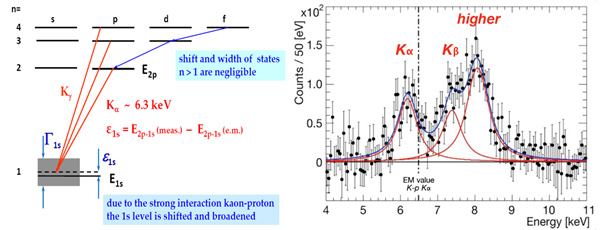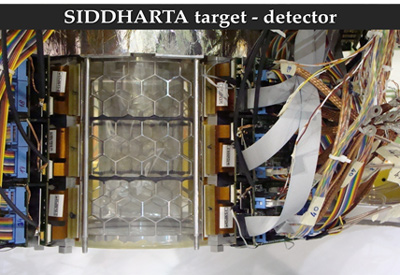State-of-the-art kaonic hydrogen atom
In particular, the kaonic atom X-ray data provide the most precise values of the antikaon-nucleon scattering lengths at threshold. Recently with SIDDHARTA, where SMI played a leading roll, the most precise measurement of the X-ray transitions to the 1s ground state of kaonic hydrogen were performed at DAFNE, the f-factory at Laboratori Nazionali di Frascati (LNF) of INFN in Italy.
Due to the strong interaction these lines are shifted compared to the pure QED values and in addition broadened due to the antikaon absorption by the proton (nucleus). The experimentally determined shift and width are related to the s-wave scattering lengths at threshold.


The SIDDHARTA experiment was performed at the DAFNE an electron-positron collider, tuned in that way to produce very efficient φ mesons at rest, which decay into back-to-back K+K− pairs with a branching ratio of about 49 %. The monochromatic low-energy kaons are stopped efficiently in a gaseous target to produce kaonic hydrogen atoms. The SIDDHARTA setup consists of a cryogenic gaseous hydrogen target working with a pressure 0.1 MPa at a temperature 23 K, resulting in a hydrogen density of 1.3 × 10−3 g/cm3.
The cryogenic target cell is surrounded by 144 silicon drift detectors (SDDs), each having an effective area of 1 cm2 and a thickness of 450 µm, developed within a European research project devoted to this experiment. The SDDs have an energy resolution of ∼ 170 eV (FWHM) at 8 keV and timing resolution below 1μsec.
Effective field theories (EFTs) provide a crucial framework for analysing the properties and interactions of hadrons and nuclei. These theories describe low-energy hadron physics implementing the symmetries of the underlying QCD theory, which leads to observable effects in the spectrum of exotic hadronic atoms.
The K-p interaction is now well understood from the recent results of kaonic hydrogen obtained from KpX (KEK-PS E228) at KEK (Japan), DEAR and finally SIDDHARTA at LNF (Italy), along with theoretical calculations based on these results.

Real part (left) and imaginary part(right) of the K-p ® K-p forward scattering amplitude extrapolated to the sub threshold region. The empirical real and imaginary parts of the K-p scattering length are deduced from the recent kaonic hydrogen measurement performed by the SIDDHARTA collaboration and are indicated by the dots, including statistical and systematic errors (W.Weise et al.).
